Winning in Court Without Speaking English:
Navigating Litigation Across Language Barriers
Legal battles should be decided on facts and fairness, not on language ability. This book is designed to empower lawyers, litigants, and judicial professionals with strategies to overcome language barriers, minimize costly delays, and ensure justice is served—regardless of fluency in English.
New Zealand’s legal system is facing an undeniable reality—an increasing number of litigants who do not speak English fluently are engaging with the courts, seeking justice in civil, criminal, and regulatory matters.
With immigration on the rise, courtrooms are witnessing more cases involving language barriers, cultural misunderstandings, and procedural delays, all of which demand additional judicial resources.
While New Zealand courts uphold the fundamental principle of access to justice, language gaps often lead to miscommunication, procedural inefficiencies, and costly delays that frustrate litigants, lawyers, and judges alike. Cases involving non-English speakers frequently take longer to resolve, require additional interpretation services, and can create avoidable complications—not because of the complexity of the law itself, but due to the challenge of navigating legal proceedings across linguistic and cultural divides.
This book is motivated by the need to bridge the gap between non-English-speaking litigants and the New Zealand court system. It is designed to:
✅ Equip litigants with practical strategies to understand, prepare, and present their cases effectively.
✅ Provide lawyers with guidance on how to advocate for non-English-speaking clients while avoiding costly misinterpretations.
✅ Offer judicial stakeholders insights into how to streamline litigation involving language barriers, ensuring fair outcomes without unnecessary delays.
Through real-world experience, practical advice, and tested strategies, this book aims to reduce inefficiencies, minimize frustrations, and ensure that the judicial system can function effectively for all users—regardless of language proficiency. With proper preparation, litigants can win their cases, lawyers can advocate effectively, and judges can oversee proceedings without unnecessary setbacks.
By implementing the tools and knowledge within this book, we can transform courtroom challenges into opportunities for fairness, efficiency, and justice that transcends language barriers.
Royal Reed is a highly respected senior partner at Meredith Connell, New Zealand’s premier litigation firm, where she specializes in complex civil disputes, cross-border enforcement, and advocacy for Chinese litigants navigating the New Zealand legal system.
With years of experience representing clients at all levels of New Zealand’s courts, Royal has built a distinguished career helping non-English-speaking litigants overcome legal and linguistic barriers in high-stakes litigation. Her deep understanding of Chinese legal judgments, international enforcement mechanisms, and bilingual legal strategy has positioned her as a leading authority in transnational litigation.
Royal made legal history in New Zealand by serving as lead counsel in the first case to successfully enforce a Chinese court judgment in New Zealand, establishing a landmark precedent for cross-border legal recognition. This groundbreaking case set the foundation for future judicial cooperation between New Zealand and China, ensuring that Chinese judgments could be recognized and enforced within New Zealand’s legal framework. Her work in this area has been pivotal in strengthening international legal ties and creating pathways for fair resolution of transnational disputes.
Passionate about equal access to justice, Royal continues to advocate for fair representation and procedural protections for Chinese-speaking litigants in civil, commercial, and regulatory cases. Her dedication to ensuring effective legal communication and strategic litigation for non-English speakers has made her a trusted advisor and champion for migrant communities facing legal challenges in New Zealand.
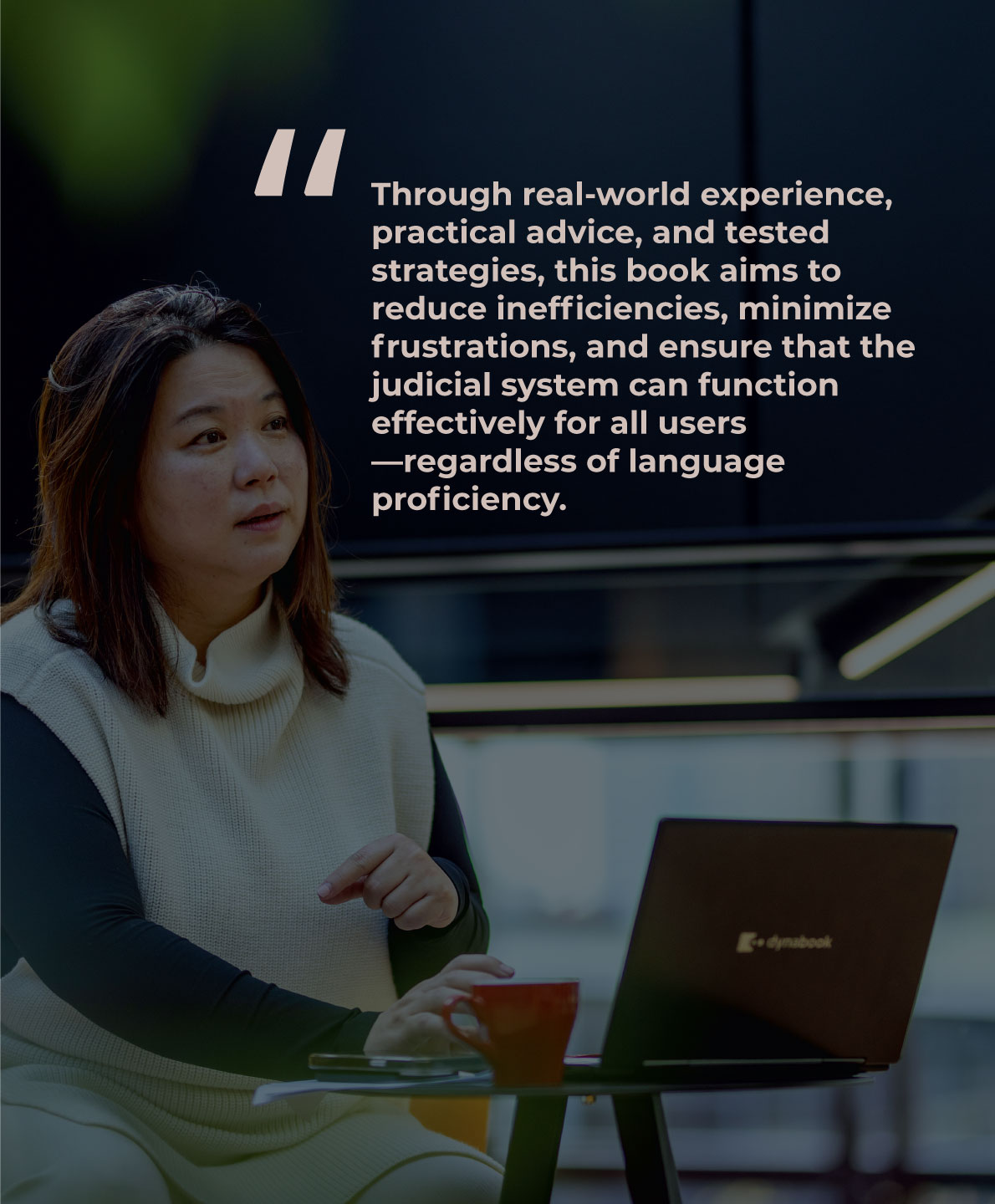
Chapter 1:
Introduction
Litigation is complex for anyone—but for those who do not speak English fluently, it can feel nearly impossible. Navigating a legal system that relies on precise language, technical terminology, and structured communication creates significant challenges for non-English-speaking litigants and their lawyers alike.
Having spent years as a bilingual litigator specializing in helping Chinese-speaking clients, I have seen firsthand how language barriers can lead to misunderstandings, procedural delays, and even unfavorable rulings—not because of the merits of the case, but because of miscommunication.
This book is designed to empower both litigants and the lawyers who advocate for them with practical strategies, professional insights, and tested solutions that bridge the language gap in courtrooms. Whether you are:
✅ A litigant struggling to present your case due to language barriers, or
✅ A lawyer representing non-English-speaking clients,
this book will equip you with the tools to navigate litigation effectively, avoid unnecessary frustration, and ensure that language limitations do not determine case outcomes.
Through my career, I have identified the three most common barriers that non-English-speaking litigants face in New Zealand courts:
1. Communication Barriers with Lawyers
Many lawyers, despite their expertise, lack the linguistic and cultural understanding necessary to fully grasp their non-English-speaking clients’ concerns. Miscommunication leads to incomplete case narratives, strategic errors, and procedural missteps that could have been avoided with better translation support.
2. Access to Qualified Interpreters
Not all interpreters are created equal. Some are highly trained professionals who understand legal terminology, while others—who may simply speak the language—introduce errors, miss critical nuances, or confuse testimony. Having the right interpreter can make or break a case.
3. Navigating Courtroom Expectations
Legal proceedings in New Zealand follow Western norms for testimony, argumentation, and demeanor, which may differ significantly from the cultural communication style of many non-English speakers. Understanding how to present testimony convincingly, work strategically with interpreters, and respond effectively to judicial questioning is key to success.
This book is tailored for:
✅ Lawyers representing non-English-speaking litigants in civil, criminal, immigration, or business-related disputes.
✅ Litigants who need a structured approach to understanding their case, preparing for court, and effectively communicating despite language barriers.
✅ Community advocates and translators assisting non-English speakers in legal matters.


Chapter 2:
Understanding the Legal System
New Zealand’s legal system follows a common law framework, meaning decisions are based on previous cases, statutes, and judicial interpretations. Understanding the hierarchy of courts helps both lawyers and litigants know where their cases will be heard:
Key Court Levels in New Zealand
✅ District Court – Handles most civil and criminal cases. Many litigants first engage with the legal system here.
✅ High Court – Deals with serious criminal cases, complex civil disputes, and appeals from lower courts.
✅ Court of Appeal & Supreme Court – Reviews contested judgments, setting important legal precedents.
✅ Specialist Courts & Tribunals – Includes Family Court, Employment Court, and Immigration & Refugee Tribunal, which may be relevant for migrant litigants.
Knowing where your case fits within this structure helps litigants and lawyers anticipate legal procedures and strategies accordingly.
Whether you are a lawyer advocating for a non-English-speaking client or a litigant preparing for court, understanding the basic flow of litigation is essential:
The Litigation Process
✅ Filing Documents – The initial paperwork must be accurate and complete to prevent delays. If legal documents contain foreign-language evidence, they must be professionally translated before submission.
✅ Pre-trial Hearings – Judges assess case readiness, rule on procedural matters, and determine how the case will move forward.
✅ Trial Process – Includes witness testimony, cross-examinations, legal arguments, and final submissions.
✅ Judgment & Appeals – Understanding when and how to challenge a decision is crucial. If a litigant misunderstands a ruling due to language barriers, their lawyer must act swiftly to correct and clarify the next steps.
✅ For Lawyers Representing Non-English-Speaking Clients:
- Use clear, structured communication to prevent misunderstandings.
- Vet interpreters thoroughly—never rely on casual bilingual speakers or family members.
- Employ bilingual legal assistants to detect translation errors and assist with cross-checking interpretations.
- Ensure foreign-language evidence is translated professionally to avoid legal risks or delays due to incomplete documents.
✅ For Litigants Facing Language Barriers:
- Learn basic legal terminology relevant to your case.
- Practice responses with an interpreter before appearing in court to refine clarity.
- Know courtroom etiquette to avoid cultural misunderstandings that could harm your credibility.
- Provide all documents to your lawyer upfront—holding back evidence to reduce translation costs can backfire later.
By understanding New Zealand’s court system, litigation procedures, and strategies for overcoming language barriers, both lawyers and litigants can strengthen their position and prepare effectively for legal battles.
Chapter 3:
The Power of an Interpreter
An interpreter is more than a translator—they are a critical link between the litigant and the court. If an interpreter misinterprets a statement, alters a witness’s words, or fails to convey tone accurately, the case itself can be compromised. Choosing the right interpreter is essential to ensuring fair representation and credibility in court.
In New Zealand, whether an interpreter is provided for free depends on the type of case and the court involved.
Situations Where Interpreters Are Provided Free of Charge
- Criminal cases – Under the New Zealand Bill of Rights Act 1990, any defendant in a criminal case who does not speak English must be provided an interpreter at no cost.
- Tribunals – Certain tribunals, such as the Immigration & Protection Tribunal, arrange interpreters free of charge for litigants.
- Police interviews – The New Zealand Police must arrange interpreters for suspects and witnesses when necessary.
- Certain Legal Aid-funded cases – If a litigant qualifies for Legal Aid, interpretation services may be included in their coverage.
Situations Where Litigants Must Pay for Their Own Interpreter
- Civil cases – In lawsuits such as contract disputes, family law matters, and commercial litigation, litigants must hire their own interpreter.
- Witness testimony – If a party calls a witness who does not speak English, they must usually pay for the interpreter.
- Employment disputes – Interpretation in the Employment Court or mediation sessions may require litigants to arrange their own interpreter.
A good interpreter must be certified, professionally trained, and experienced in legal settings. In New Zealand, interpreters should ideally come from recognized training programs, such as:
✅ Auckland University of Technology (AUT) Interpreting and Translation Programme
✅ New Zealand Society of Translators and Interpreters (NZSTI) Accredited Interpreters
✅ Department of Internal Affairs (DIA) Interpreting Services
Avoid using unqualified individuals, such as:
❌ Helpful friends or acquaintances who lack formal legal training.
❌ Children or family members of litigants, who may introduce bias or fail to capture legal nuances accurately.
❌ Random bilingual individuals who may not understand complex legal terminology.
For lawyers, ensuring accurate interpretation involves:
✅ Vet interpreters based on certifications and legal experience.
✅ Avoid interpreters with personal connections to the litigant to prevent bias.
✅ Work with bilingual legal assistants to monitor translation accuracy.
✅ Transcribe translated statements to verify accuracy.
✅ Leverage AI-powered transcription tools for cross-checking translations and protecting against misunderstandings.
For litigants, ensuring proper interpretation means:
✅ Speaking in short, clear sentences to avoid confusion.
✅ Confirming that the interpreter understands legal terminology before proceedings begin.
✅ Requesting clarification if something sounds incorrect or misleading in translation.
✅ Seeking bilingual legal support whenever possible to help catch potential misinterpretations.
By choosing the right interpreter, ensuring translation accuracy, and working strategically with legal professionals, litigants can prevent miscommunication and strengthen their case in court.
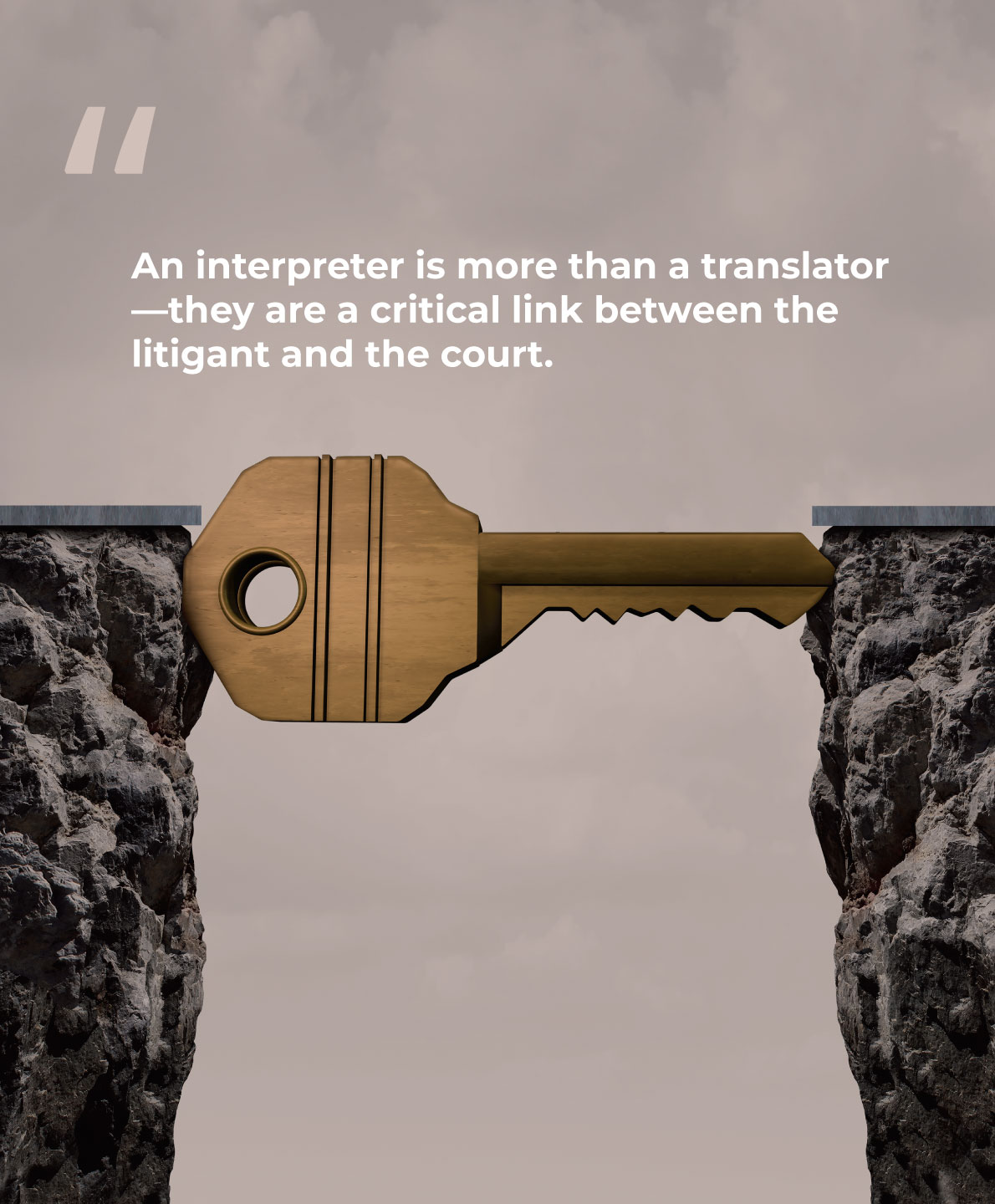

Chapter 4:
Using Free Technology for Legal Interpretation
For litigants who cannot afford professional interpreters or need translation support outside of court, free technology can offer practical solutions for communication. While these tools cannot replace human expertise, they can be helpful for lawyers preparing cases and litigants understanding key legal concepts.
Several widely available online tools provide instant text and voice translation, allowing litigants and lawyers to communicate more effectively before formal legal proceedings.
✅ Google Translate – Offers free text and voice translation in multiple languages. Useful for translating emails, legal notes, and basic conversations.
✅ Microsoft Translator – Provides real-time translation for conversations, allowing lawyers and clients to talk in different languages during meetings.
✅ DeepL Translator (Free Version) – Known for higher accuracy in complex sentence structures.
⚠️ Limitations – While these tools help with basic communication, they should not be relied upon for formal legal documents or court testimony, as automated translations may miss key legal nuances.
Video conferencing platforms like Zoom and Microsoft Teams offer free live transcription and translation features, making them useful for lawyer-client meetings when one party does not speak English fluently.
✅ Zoom Live Transcription – Automatically transcribes spoken language during meetings, helping litigants review discussions afterward.
✅ Microsoft Teams Live Captions & Translation – Provides real-time captioning and translation, ensuring clearer communication between lawyers and clients.
These features allow litigants to follow meetings more easily and verify important discussions to prevent misunderstandings.
For cases where lawyers and clients need to review spoken exchanges, free AI-driven transcription tools can capture and convert spoken language into text.
✅ Otter.ai (Free Plan) – Provides speech-to-text transcription for up to 300 minutes per month, useful for reviewing lawyer-client discussions.
✅ YouTube Auto-Captions – If a legal discussion is recorded privately, uploading it to YouTube as an unlisted video can generate free automatic captions.
✅ Whisper AI (Open Source) – A free AI-powered speech recognition tool that can convert spoken discussions into text with high accuracy.
Using transcriptions ensures that both lawyers and litigants can verify interpretations and check for inconsistencies in communication.
While free translation and transcription tools offer valuable support, they should be used only for preparation and informal communication—not for official court proceedings where human interpreters remain necessary.
By integrating Google Translate, Zoom, Teams, and free AI transcription tools, lawyers and litigants can reduce barriers, improve accessibility, and strengthen case preparation when formal interpretation services are unavailable.
Chapter 5:
Communicating with Your Lawyer
Successful litigation relies not only on legal strategy but also on clear and precise communication between lawyers and their clients. Language barriers can make this process challenging, but with the right approach, both lawyers and litigants can work together effectively.
If you’re representing a client who does not speak English fluently, it’s crucial to implement structured communication methods to avoid misunderstandings. Some best practices include:
✅ Using simple, direct language – Avoid legal jargon unless necessary.
✅ Providing written summaries – After important meetings, offer a brief written recap in clear and simple language, ideally with a translated version.
✅ Confirming understanding – Ask the client to repeat key legal points back in their own words to verify comprehension.
✅ Utilizing bilingual legal assistants – If available, assign a bilingual assistant to facilitate smoother communication and check interpreter accuracy.
✅ Pre-trial preparation sessions – Schedule mock interviews and practice sessions with interpreters to ensure the client is comfortable before formal proceedings.
If you are a litigant facing language barriers, the following steps will help you stay informed and proactive in your case:
✅ Ask for written explanations – If your lawyer explains something you don’t fully understand, request a simplified written summary for reference.
✅ Prepare your statements in advance – Write key points ahead of time in your own language so your interpreter or bilingual legal assistant can help refine them for clarity.
✅ Request interpreter verification – If working with an interpreter, ask your lawyer to confirm that translations accurately reflect your statements.
✅ Don’t hesitate to ask questions – Legal matters can be complex—if anything is unclear, speak up immediately to prevent misunderstandings.
✅ Practice with technology tools – Use free translation tools (see Chapter 4) to review legal documents and discussions independently.
✅ Ensure primary evidence is professionally translated – If your case relies on emails, contracts, messages, or other written evidence in a foreign language, arrange for accurate, certified translations before presenting them to your lawyer. Incomplete or poorly translated documents can lead to misunderstandings, weaken arguments, and create risks that may harm your case.
✅ Do not withhold relevant documents – Some litigants avoid submitting their full range of documents due to concerns about translation costs. This can backfire—if missing evidence is discovered later, it may jeopardize case strategy, create unexpected complications, and increase costs unnecessarily. Always provide your lawyer with all relevant records upfront, ensuring they have a full picture of your case from the beginning.
A well-prepared client and a strategically aware lawyer always have an advantage in court. By overcoming language barriers with structured communication, proper translation support, and effective collaboration, litigants can ensure they are heard, understood, and fairly represented.
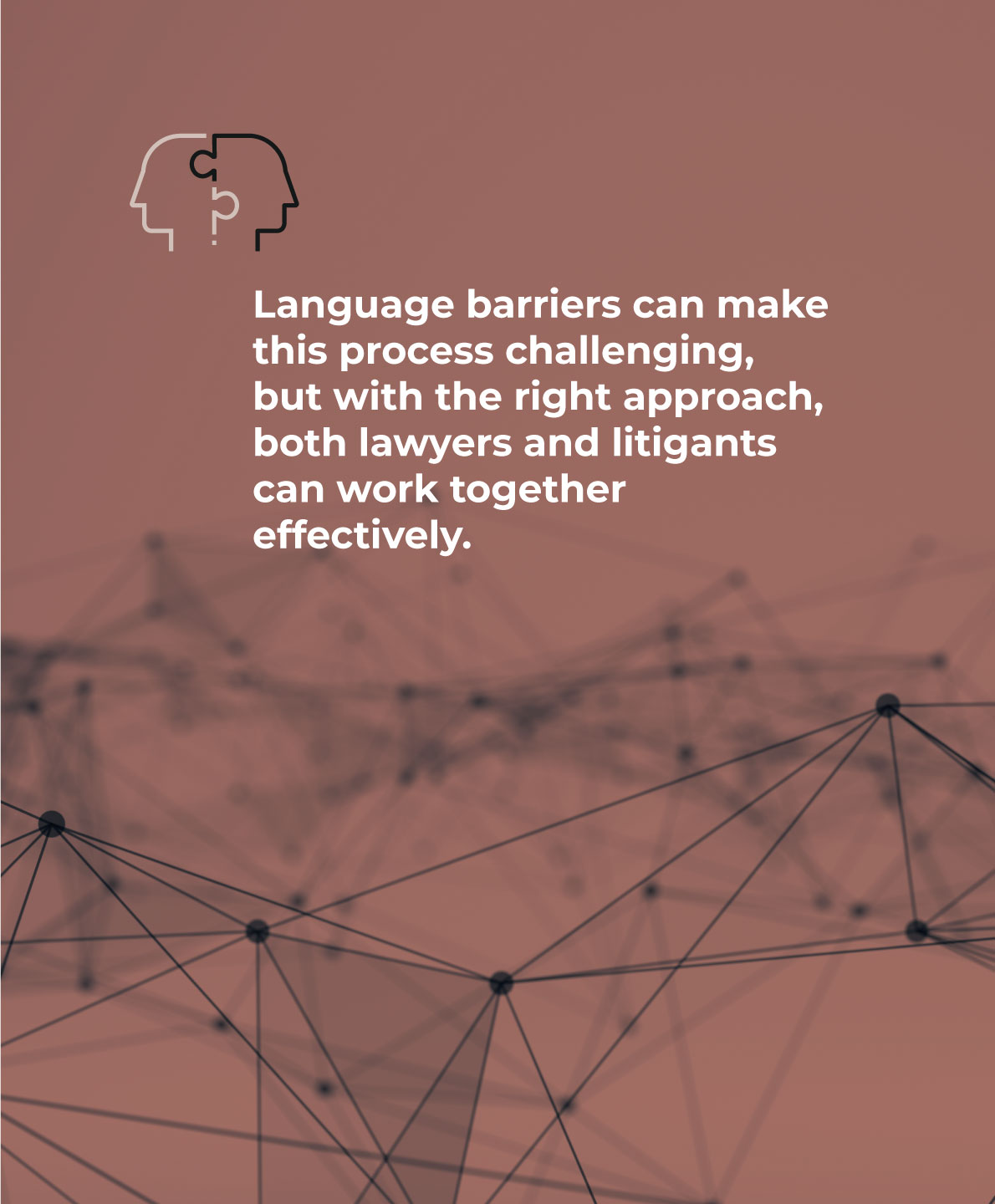
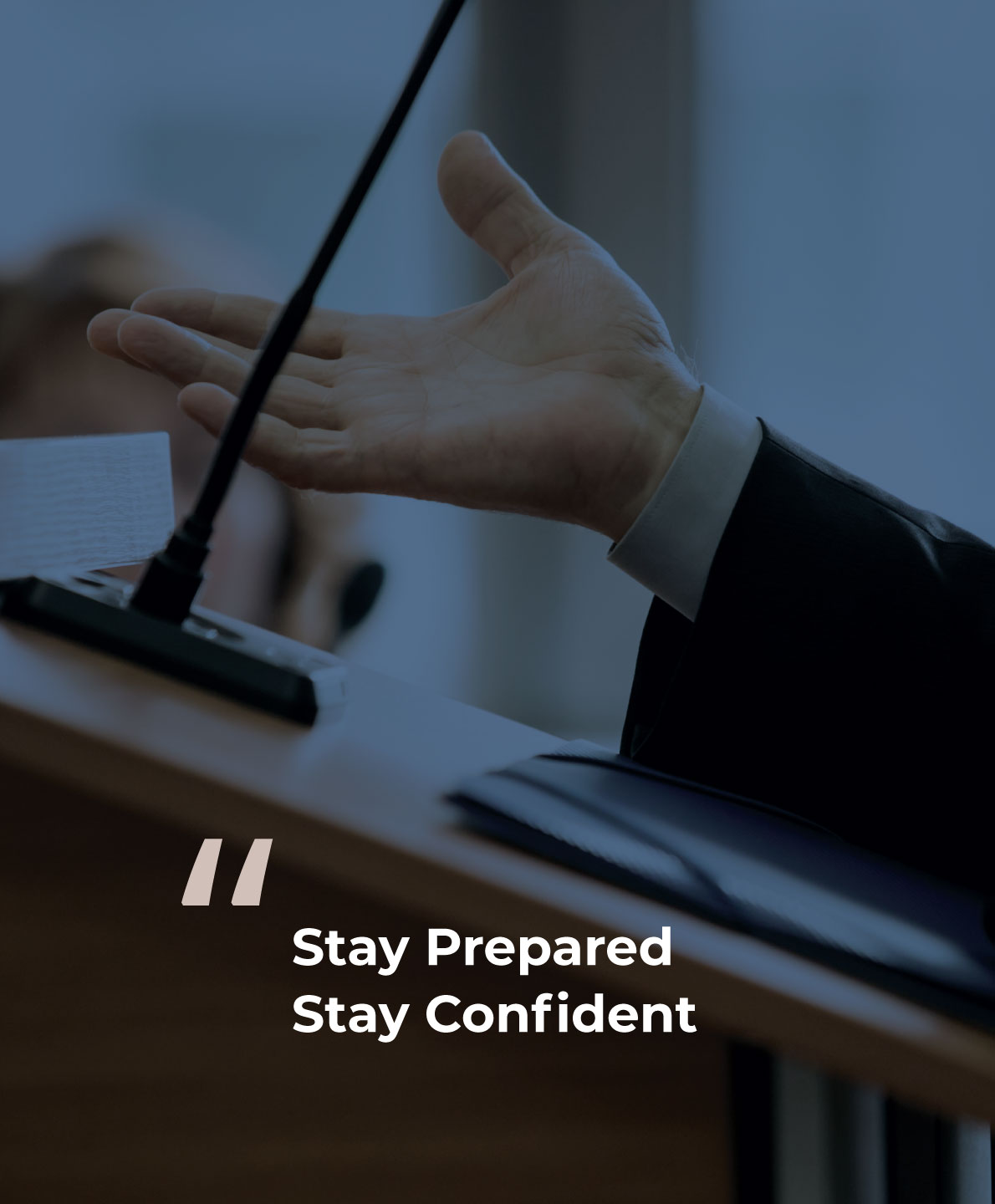
Chapter 6:
Presenting Your Case – Winning the Courtroom Battle
Stepping into the courtroom is not unlike entering a battlefield. You and your legal team are soldiers in formation, armed with facts, arguments, and strategy to fight for justice. No warrior charges into battle unprepared—just as no litigant should walk into court without a clear plan.
Before Trial: Tactical Preparation
✅ Know Your Evidence – Your documents, witness statements, and legal arguments are your weapons. Ensure every piece of evidence is well-prepared, translated correctly, and fully understood.
✅ Train with Your Interpreter – Just as soldiers rehearse battle strategies, you must practice working with your interpreter to ensure smooth courtroom communication.
✅ Master the Terrain – Understand courtroom structure, judicial expectations, and the tactics opposing counsel may use. Anticipate challenges before they arise.
✅ Trust Your Team – Your lawyer, interpreter, and legal assistants are your allies. Communicate openly, disclose all relevant facts, and remain aligned in strategy to prevent surprises that could weaken your case.
The moment you step into the courtroom, the battle is underway. Your role as the litigant is to stay composed, focused, and precise, just as a soldier maintains discipline under pressure.
When presenting your testimony, be clear, direct, and confident. Avoid lengthy explanations—stick to the facts and ensure your interpreter conveys your statements accurately.
✅ Speak in short, clear sentences – This makes translation more precise and minimizes confusion.
✅ Stay composed under questioning – Opposing counsel may try to challenge or unsettle you. Stand firm, take a breath, and respond calmly.
✅ Use translations strategically – If uncertain, ask for clarifications or corrections to ensure that every word represents your true intent.
Just as in battle, the opposing side will attempt to counter your arguments and weaken your position. Be prepared for aggressive questioning and avoid making reactive statements that could harm your case.
✅ Listen carefully to the full question before responding – Do not rush into an answer.
✅ Remain calm and do not argue – Emotional responses can be used against you. Stay professional and composed.
✅ Stick to your prepared narrative – Avoid speculation or adding unnecessary details that could be twisted by the opposing side.
✅ Let your lawyer intervene when needed – If opposing counsel asks inappropriate or misleading questions, your lawyer will step in to protect your position.
In war, soldiers must trust their commanders to guide them through the battlefield. In litigation, you must trust your lawyer to make strategic legal decisions that strengthen your case.
✅ Follow your lawyer’s advice – They understand the terrain better than anyone. If they tell you to answer concisely or avoid certain responses, listen.
✅ Allow legal arguments to play out – Not every battle is won in direct combat—sometimes, a lawyer’s legal reasoning and strategic positioning win the case more than witness testimony.
Win or lose, every legal battle comes with consequences and lessons learned.
✅ If you win – Ensure that you fully understand the final judgment, enforcement of the court’s order, and next steps.
✅ If you lose – Discuss with your lawyer whether an appeal is possible and what can be done to strengthen your position for the future.
✅ Regardless of outcome – Remember that every legal battle is an opportunity for growth, and preparation is the key to success.
In the courtroom battle, victory belongs to those who are well-prepared, strategically positioned, and supported by a strong team. With clear communication, effective legal representation, and the right mindset, even those who do not speak English fluently can win the fight for justice.
Chapter 7:
Leading and Crossing Witnesses Through an Interpreter
Cross-examination is one of the most strategic moments in litigation, allowing lawyers to control the narrative and dismantle the opposition’s case. However, when working with an interpreter, traditional cross-examination techniques must be adapted, or the power of carefully structured questions can be lost in translation.
Rather than relying on long-winded leading questions, lawyers must simplify phrasing, control pacing, and avoid ambiguity to ensure that the interpreter, the judge, and the witness remain aligned and focused.
In English, layered questioning can pressure a witness into contradictions or admissions. However, when using an interpreter, complexity often backfires. If questions are too long or packed with multiple ideas, interpreters may struggle to convey them properly, leading to:
– Loss of logical flow, where meaning gets diluted.
– Witness confusion, causing hesitation or unintended responses.
– Distraction for the judge, as misinterpretations take center stage.
Effective Cross-Examination with an Interpreter:
✅ Ask one idea at a time – Keep questions short, direct, and structured.
✅ Use clear and simple language – Avoid idioms, technical jargon, or cultural references that may not translate smoothly.
✅ Control the tempo – Speak at a pace that allows interpreters to process each question fully before the witness responds.
✅ Pause between questions – Allow time for accurate translation, avoiding rushed exchanges.
When questioning through an interpreter, maintaining courtroom control is critical. If a witness becomes evasive, lawyers must redirect them with precision, rather than relying on aggressive challenges that may confuse both the interpreter and the judge.
Techniques for Regaining Control:
✅ Repeat and rephrase – If the witness avoids answering, reframe the question in simpler terms rather than pushing harder with legal jargon.
✅ Use confirmation tactics – Ask direct “yes or no” questions to lock in responses.
✅ Watch the interpreter’s rhythm – If the interpreter hesitates or struggles, adjust pacing and structure accordingly.
✅ Focus on facts over argument – When language barriers exist, letting evidence speak for itself is often more effective than rhetorical traps.
Poorly structured questioning can derail an examination, leaving the judge focused more on translation issues than on the witness’s testimony.
Common Pitfalls to Avoid:
❌ Complex sentence structures – Long, multi-part questions risk misinterpretation.
❌ Leading questions with nuance – Some techniques that work well in English (suggestive phrasing, sarcasm, or implied meaning) may fail in translation.
❌ Rapid questioning tactics – Quick exchanges make it harder for interpreters to relay responses accurately.
❌ Cultural assumptions – Some phrases, logic patterns, or emotional cues do not translate the same way in every language.
Litigation is a battle of facts, timing, and controlled strategy. When working with an interpreter, cross-examination becomes a tactical exercise in clarity—where every question is a weapon, and every response must land precisely.
Victory comes not from overwhelming the witness with complicated questioning, but from direct, controlled, and strategically placed inquiries that remain powerful—even when translated.

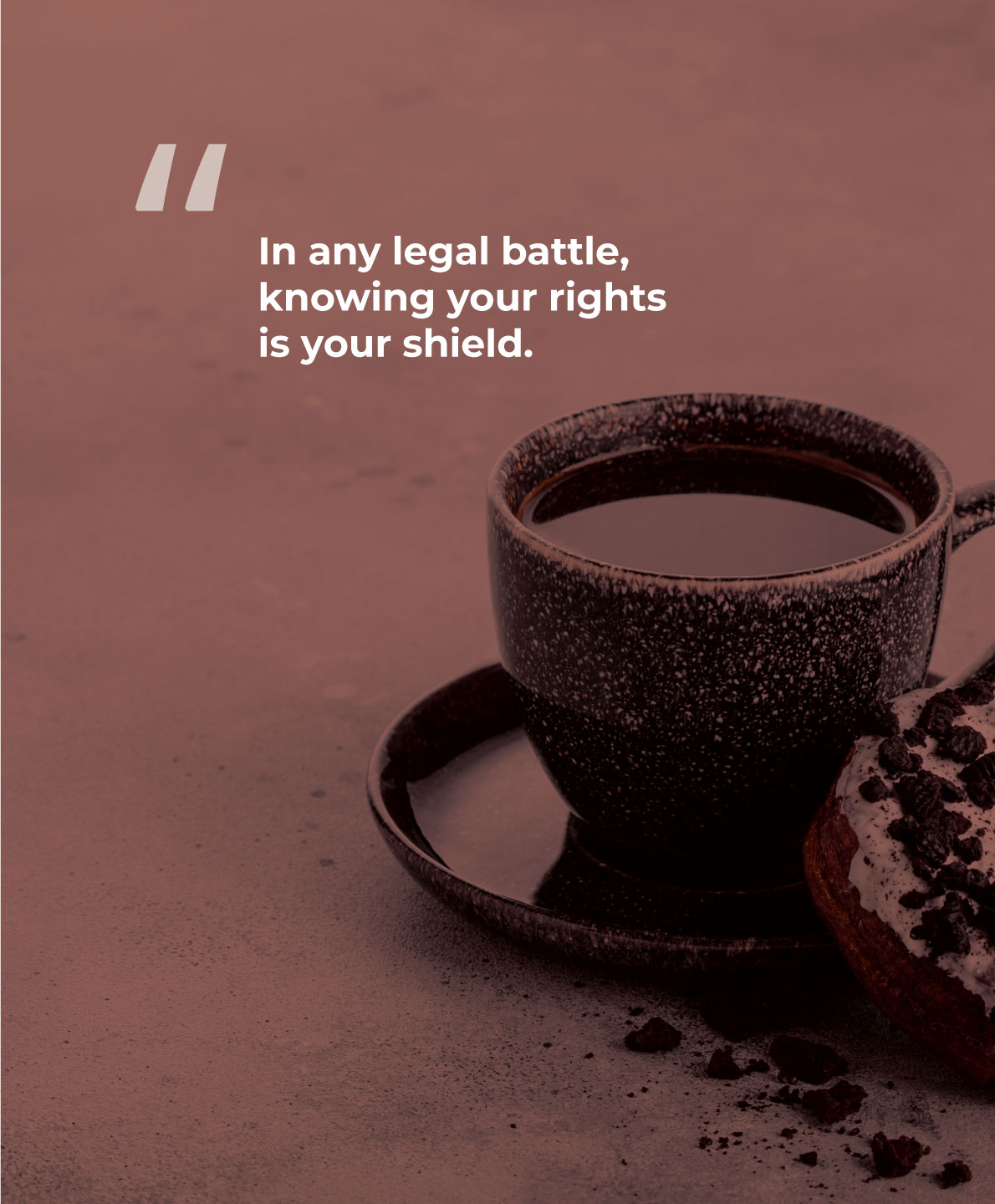
Chapter 8:
Knowing Your Rights as a Non-English Speaker in Court
In any legal battle, knowing your rights is your shield. Many non-English-speaking litigants fear that their lack of fluency will put them at a disadvantage, but legal systems around the world recognize the need for fair treatment and access to justice, regardless of language barriers.
In most courts, individuals have the right to:
✅ Understand legal proceedings in a language they can comprehend.
✅ Access interpretation services in criminal cases or essential legal matters.
✅ Receive translated versions of critical legal documents when necessary.
Courts have an obligation to ensure fairness in trial proceedings, meaning language barriers must not prevent a litigant from understanding their rights or participating in their case.
In many legal systems, interpretation services are provided free of charge for criminal cases, and sometimes for essential civil matters such as immigration or asylum claims. However, for general civil disputes, litigants are often responsible for hiring their own interpreter.
To protect your rights, you should:
✅ Request an interpreter as early as possible – Do not wait until trial; ensure arrangements are made in advance.
✅ Verify interpreter qualifications – Courts should not assign an interpreter randomly; they should be trained professionals familiar with legal terminology.
✅ Challenge inaccurate translations – If you suspect misinterpretation, raise concerns immediately before the court.
✅ Demand equal access to legal proceedings – Judges and court officials must ensure that language barriers do not interfere with justice.
Courts rely on clarity, structure, and logical argumentation to assess cases fairly. When litigants struggle to communicate effectively or translators fail to accurately convey key points, the court may find it difficult to fully grasp the arguments being presented. This confusion can lead to adverse inferences, where the judge sees the case as illogical, weak, or lacking foundation, simply because it is not properly understood.
Furthermore, if a lawyer also struggles to interpret or make sense of their client’s narrative, they may fail to advocate effectively, leaving the litigant at a serious disadvantage. To prevent this:
✅ Ensure professional interpreters are used—accuracy is critical.
✅ Provide written summaries to lawyers and judges to reinforce oral arguments.
✅ Use structured testimony with clear, fact-driven statements.
By actively managing interpretation challenges, litigants can prevent unnecessary judicial confusion and avoid misinterpretations that could harm their case.
Legal documents, police reports, and opposing party submissions may be in a language you do not understand. Protect your rights by:
✅ Requesting professional translations of key documents.
✅ Working with your lawyer to verify translated versions.
✅ Using bilingual assistance to cross-check critical information before trial.
The courtroom is a battlefield, but understanding your rights, securing qualified interpretation, and advocating for fair treatment ensures that justice is not lost in translation. Whether in criminal, civil, or immigration cases, litigants must take proactive steps to protect their ability to participate fully in legal proceedings.
